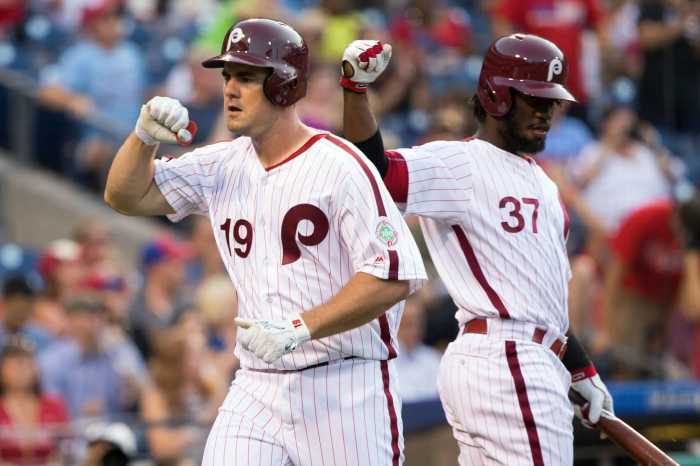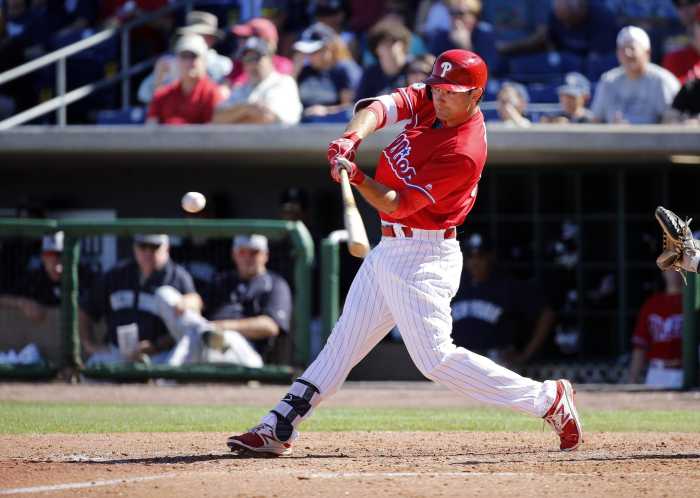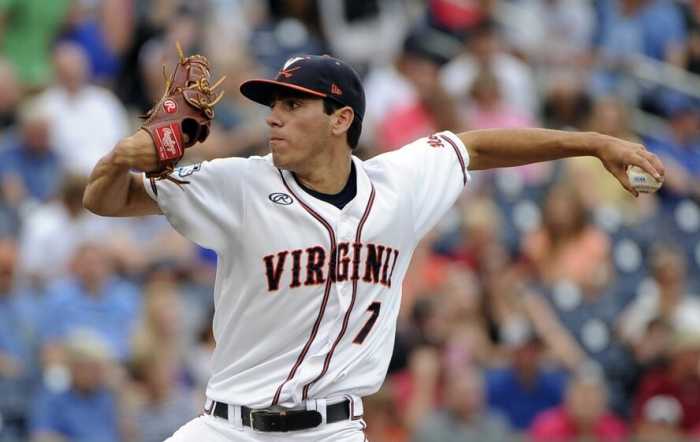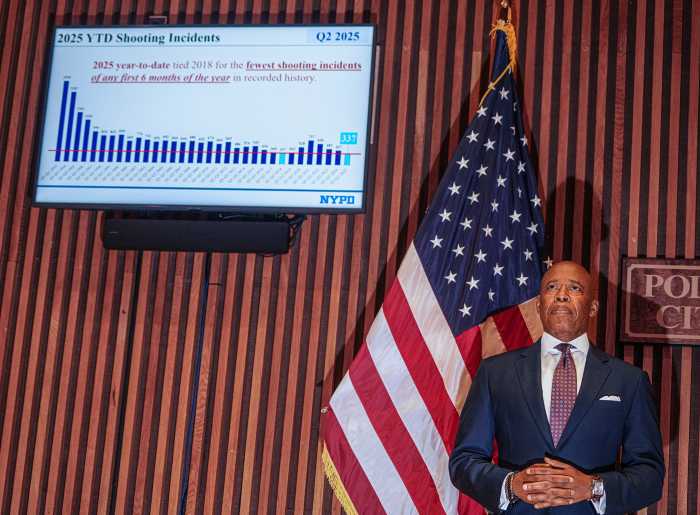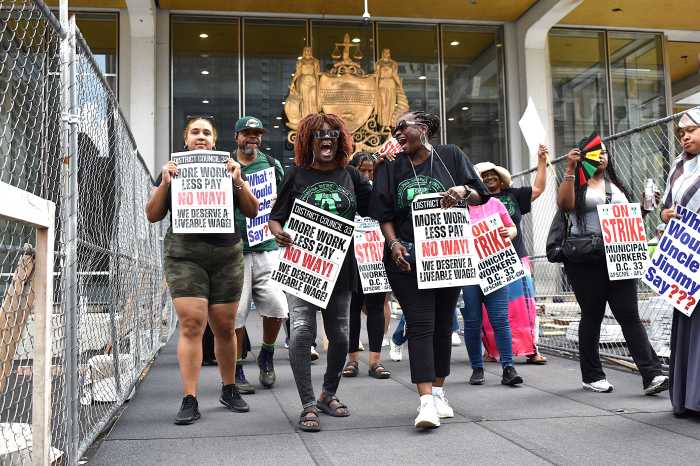I must admit, time caught up on me a little bit this past week. Had it not, this piece would have already been made available to you. Unfortunately, the facts are what they are. But I digress, and we soldier on, continuing the grades of the Phillies first half (and early part of the second half) of the season. Last week, we broke down how the infield has fared this season, and we’ll continue by moving into the grassy plain they call the outfield.
Rhys Hoskins: B
One day, perhaps sometime in the near future, Rhys Hoskins will move back to his rightful place at first base. Until then, Carlos Santana occupies that space, and Hoskins has been relegated to the outfield. He’s made himself a serviceable left fielder over the last two seasons, but his true claim will come at first base.
Hoskins has battled injuries throughout the season but has still managed to appear in 92 games. He’s been about what I expected he would be in his second big league season. If you expected a .300 season and 40 bombs, I have unfortunate news for you: It likely wasn’t going to happen. Major League pitchers now have tape on Hoskins and have a better understanding on how to pitch to the young slugger. Despite the rolodex growing, Hoskins has been one of the more consistent hitters on the Phillies roster this season. He’s hit .255 but he currently sports a .367 on base percentage. His 56 walks this season are second on the team, behind just Cesar Hernandez and Carlos Santana. Hoskins has hit 18 homeruns through 92 games, good for most on the team. Through his first 142 games, Hoskins has hit 36 homeruns and driven in 93 runs. Think about that for a moment. In less than a full season, Hoskins is closing in on 40 homeruns and 100 RBI’s. Taking into account that Hoskins has averaged a homerun every four games and four RBI’s every five games, he’s on pace to hit another five homeruns and drive in 16 more runs over his next 20 games. Those numbers will only improve as he matures. The ceiling of this young hitter is very, very high.
Odubel Herrera: A-
Herrera can certainly be frustrating at times. That, however, is nothing new in the annals of Phillies’ centerfielder history. Shane Victorino played a similar style. So did Doug Glanville. It’s just status quo for the Phillies.
But what Herrera has provided, especially this season, is a big league stick in a lineup devoid of power. In 98 games, Herrera has hit .276. That number is, surprisingly enough, ten points lower than his career average. But what Herrera has done well this season is drive the ball. He’s already broken personal career bests in homeruns (18) and RBI’s (56), and the Phillies still have over 60 games left to play. Herrera is on pace to hit 25 homeruns and drive in over 90 runs. That would put him among the league’s best centerfielders this season. And let’s not forget the 45 game on base streak that Herrera carried into May to begin the year.
But what is has impressed me most about Herrera this season is his contoured plate approach. Herrera has lowered his strikeout percentage and risen his percentage of walks from last season. He’s seeing slightly more pitches per at bat, but the number isn’t large enough to make a huge difference. What does make a difference is his percentage in swinging strikes, which is down nearly a full percentage point from a season ago.
The approach is better, which, in turn, is resulting in better numbers. The Phillies may not wind up using Herrera as their three-hole hitter when the team is at full capacity, but in the meantime, the team should have confidence in Herrera.
Nick Williams: C+
The numbers that Nick Williams have produced don’t really dictate a C+ grading, but his season comes with a large caveat. Throughout the first two months of the season, Williams couldn’t hit a beach ball on a tee. He split time with Aaron Altherr in right field, and was verbally frustrated at not getting significant playing time early in the season.
But Williams has transformed into a serviceable hitter over the last few weeks, raising his average to a well-rounded .250. Over his last 15 games, Williams has hit .291 with two homeruns and eight RBI’s. In 93 games, he’s matched his total homeruns (12) from a season ago. It has taken him an additional ten games to do so, but again, after the abysmal start Williams had, I think he’ll happily take where he currently is. Much like Herrera, Williams’ strikeout rate is down, his walk percentage is up and he’s seeing more than two-tenths of a pitch more per at bat. The number, on the surface, is low, but stretched out over the lifespan of a season, and the pitches begin to add up.
Should Williams remain at the pace that he is currently sitting, you could see his average rise into the high .260’s by the end of the season. If that were to be the case, Williams could establish himself as a true, every day starter for the foreseeable future.
Aaron Altherr: F
There it is, the second “F” grade of the season so far, and we haven’t even gotten to the pitching staff yet. Altherr has simply not been very good this season, and has, since the first article was written, been sent down to Triple-A Lehigh Valley to get his head straight. In 89 games, Altherr hit just .171. That’s just 36 hits in 210 at bats. If he were to not make his way back to the big leagues, this will be the second season in four years that Altherr finished under the Mendoza Line. Altherr struckout 81 times in 89 games, a number that has forced his strikeout percentage up over seven full points, from 25.2 percent to 32.7 percent. When you factor that seven percent increase over the course of a full season, Altherr would average around 150 strikeouts in a full season.
Altherr’s lasting impact thus far has been his high walk percentage. Despite struggling at the plate, Altherr has a near .300 on base percentage thanks to his 33 walks. That number is good for fourth on the team. He’s walked in over 13 percent of his plate appearances this season. Those walks, however, were not enough to keep him around, as the team has elected to go with an additional infielder, Trevor Plouffe, for the time being. Altherr will likely find himself back on the roster by September call ups, when the roster expands to 40 players. He may not, however, be included on the active roster if, or when, the Phillies make the playoffs.
Mandatory Credit: Aaron Doster-USA TODAY Sports


